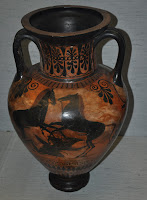This exhibition is currently on show at Manchester Art Gallery www.manchestergallaries.org and ends on the 29th January 2012.
The exhibition itself is showing on the top floor of the galley in a large bright open area that allows for close examination of the pictures but also viewing from a distance.
The exhibition is broken down into a number of themes
- The Artist and his Family
- The Early Period
- The Change of Direction
- The Draughtsman
- The Landscape Painter
- The Painter of Modern Life
- The Storyteller
- The Portrait painter
- The Designer
- The Manchester Period
There is a complimentary exhibition being held at Manchester Town Hall, where the murals he was commissioned to paint are on show. (Selected Sundays throughout the time of the exhibition)
A free exhibition guide was available. (This will form part of my ongoing development of a exhibition\gallery portfolio)
One of the most useful aspects of the guide relates to his piece entitled Work.
The piece is large piece of work and is extremely detailed, and at the time Madox Brown painted it, he produced a pamphlet describing the characters.
 |
| Work 1852 - 1863 Oil on canvas Manchester City Galleries |
- The 'Brainworkers' (Thomas Carlyle and Rev. Frederick Maurice)
- The Navvies
- The Poor Children
- The Chickweed Seller
- The Rich Ladies
- The MP and his Daughter
- The Beer Seller
- The Irish
An example of a character description is produced below
| Details of a navvy in work oil on canvas 1852 - 1863 |
The navvies are the workmen digging the road. Brown placed then in the centre
of the painting to underline the central contribution their physical work makes to society. Each navvy is engaged in different tasks - digging, sieving earth, carrying bricks, pausing for a drink, mixing cement - and each is different in age, character and physique. Brown wrote that the young navvy on the left 'occupies the place of the hero' of the group. (Taken from the exhibition guide)
Not only did this type of description greatly assist with the exhibition visit but has provided a model for annotations of large complex and detailed paintings.
One of the challenges I face is interpreting aspects of paintings that may be repeated in different pictures.
For example in the painting The Last of England, the mother is holding the hand of a young child - we do not see the child(apart from their hand ) as they are wrapped up in their mothers shawl, protected from the weather. The information presented next to the painting suggested that by just showing the fingers of the hand Madox Brown was pointing to the vulnerability of the child.
Compare that to The Irish Girl, she has wrapped herself up in a shawl, with the fingers of her left just showing as she holds a small bunch of blue flowers (Cornflower?)
Both are vulnerable - the baby at sea with it's parents and the Irish Girl, looking away from the viewer. Is the use of showing partial hands a tool the artist use to indicate vulnerability?
The Irish Girl was displayed next to The English Boy and I have included post cards of these paintings in my annotation log, together with my observations and the gallery notes.
I thought two of the paintings exhibited (Walton on the Naze 1860 and The Hayfields 1855 ) showed an'impressionist' style, could this be because of his 'European' artistic education, he attended the Bruge, Ghent and Antwerp Academies and not the Royal Academy London as did may of his English contemporaries.
The gallery notes accompanying the respective paintings indicate his interest in 'light' similar to the impressionists.
Not only did this type of description greatly assist with the exhibition visit but has provided a model for annotations of large complex and detailed paintings.
One of the challenges I face is interpreting aspects of paintings that may be repeated in different pictures.
For example in the painting The Last of England, the mother is holding the hand of a young child - we do not see the child(apart from their hand ) as they are wrapped up in their mothers shawl, protected from the weather. The information presented next to the painting suggested that by just showing the fingers of the hand Madox Brown was pointing to the vulnerability of the child.
Compare that to The Irish Girl, she has wrapped herself up in a shawl, with the fingers of her left just showing as she holds a small bunch of blue flowers (Cornflower?)
 |
| Image of hands from The Last of England |
 |
| Image of from an Irish Girl |
Both are vulnerable - the baby at sea with it's parents and the Irish Girl, looking away from the viewer. Is the use of showing partial hands a tool the artist use to indicate vulnerability?
The Irish Girl was displayed next to The English Boy and I have included post cards of these paintings in my annotation log, together with my observations and the gallery notes.
I thought two of the paintings exhibited (Walton on the Naze 1860 and The Hayfields 1855 ) showed an'impressionist' style, could this be because of his 'European' artistic education, he attended the Bruge, Ghent and Antwerp Academies and not the Royal Academy London as did may of his English contemporaries.
The gallery notes accompanying the respective paintings indicate his interest in 'light' similar to the impressionists.
 |
| Walton on the Naze 1860 |
'the clear warm afternoon light, the rainbow, the moon and the mirage like reflection of the ship sails in the clouds give a dream like serenity'.
 |
| The Hayfields 1855 |
'what a wonderful effect I have seen this evening in the hay fields, the warmth of the uncut grass; the greeny grayness of the unmade hay in furrows or tufts with lovely violet shadows'.

















